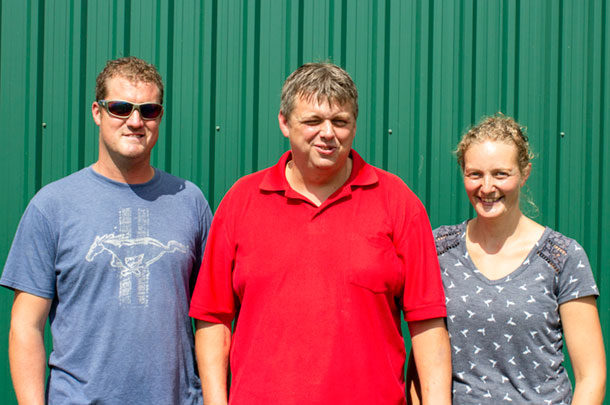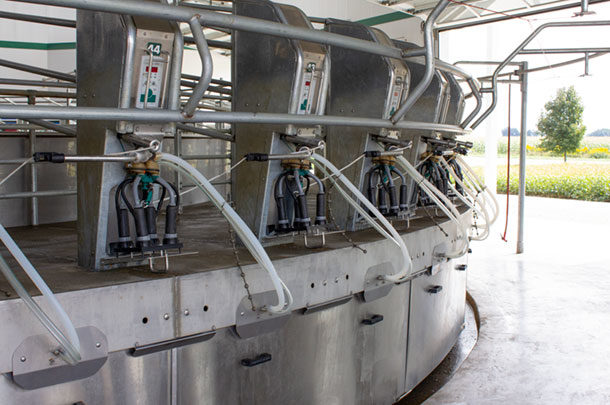Several years later, they built an addition on the barn, and a few years after that, they built a dry cow barn to manage the farm’s growth. It was the farm’s latest build – a new 50-stall external rotary parlour and a sand-bedded, six-row freestall barn – that was the featured part of the farm stop on the Progressive Dairy Operators’ September bus tour in the region.
The rotary parlour allows them to milk 210 to 220 cows per hour with three people. It reduced the milking time for this 480-cow farm from six and a half hours to two and a half hours per shift.
“We like the consistency of the rotary,” Teun De Beer said to the tour group. “We can control the speed of the deck. For the people, it is a consistent job and they are not rushing from one side to the other.”
At each shift – one at 5 a.m. and the other at 4:30 p.m. – there are two people stationed at the front of the rotary. The first person uses a teat scrubber to clean the teats. This has cleared up any inconsistency in wiping as whoever holds the brush will clean the same every time. “The teats are cleaner and it’s more consistent,” De Beer said, noting they do have to replace the brush inside the unit every three weeks.
When asked if it helped with the farm’s somatic cell count, De Beer said the count did go down, but he also attributes that to less overcrowding and less time spent in the holding area.
The second person stands five places away and attaches the milking unit, while the third person roams and post-dips.
Each person has a designated task for cleanup, which is relatively easy compared to the old parlour. “It takes about five to 10 minutes after the last cow is out,” De Beer said. They are aided by a flush system to rinse the manure from the holding area.
All breeding and treatments are performed in the morning. As cows exit the rotary, there are two sort gates to usher any cows needing attention into different areas. The first sort gate sends cows to a holding pen, while the second sends them to lanes either to a chute or smaller holding pens depending on the task of the day. There is a vet office nearby and dry hay along the headlocks since it doesn’t spoil.
Milking cows are housed in the sand-bedded, six-row freestall barn that was completed in February. Mature cows are kept on one side of the barn and younger cows on the other. The barn has insulated roof panels, and they capped the I-beams to keep birds from nesting. Stalls are bedded with a fine sand that seems to pack more than they’d like. De Beer said they are looking into stall groomers to loosen it up. A brisket pipe along the front of the stalls helps position the cows and saves on sand, he said. New sand is added every two weeks.
The farm’s 16-degree manure scrapers run continuously to a hole at the end of the barn. Manure is pumped to a 2-million-gallon manure storage unit. Manure is transported to fields by tank and direct line. They have a separate pit for runoff from the bunkers. This is 99.9 percent water, and they use it for irrigation.

The barn is set up with perimeter feeding. The cows are fed once a day, and all milking cows get the same ration. Forage is split two-thirds corn silage and one-third haylage because corn is easier and cheaper to grow, De Beer said. The rest of the ration contains high-moisture corn, soybean meal, canola meal, distillers grains, minerals and soy hulls.
The refusals go to the heifers, which have their own ration. They also feed a single, dry cow ration that contains more straw and hay than the milking cow diet.
Cows have rumination monitors now, and De Beer said they are still learning how to fully utilize them. So far, they are monitoring rumination by the group to make ration adjustments and will sort individual cows that are not eating enough.
Activity monitors are used for heat detection. Using parent average, they breed the top 60 percent of cows to conventional semen and the bottom 40 percent to beef, and raise the British Blue crosses themselves. The top 75 percent of heifers are bred to sexed semen and bottom 25 percent to conventional semen. Bulls are selected for protein, daughter pregnancy rate, herd life and somatic cell count. De Beer said he likes high protein content in milk and uses daughter pregnancy rate because he is unsure about the future of hormone use in cattle.
At the time of the tour, the De Beers were in the process of converting some freestalls in the dry cow section of the older barn to straw packs. They had a straw pack for fresh cows and wanted a separate one for sick and lame cows.
Click on the image above or click here to see more photos of the new parlor and barn.
Work on the farm is done by brothers Teun and Ben De Beer. They have three full-time employees and some part-time milkers. In addition to the dairy, they grow alfalfa, corn and soybeans on 1,000 acres. They have partnered with a neighbour for custom field work. Each farm is responsible for certain tasks, which helps reduce the investment in equipment.
With a new 50-stall rotary and freestall barn, Compass Dairy Farms Ltd. was able to reduce overcrowding and leave a little more room to grow for its next 20 years. ![]()

-
Karen Lee
- Editor
- Progressive Dairyman
- Email Karen Lee
PHOTO 1: The installation of a 50-stall rotary parlour helped the De Beers cut down on milking time, reduced time spent in the holding area and improved the consistency of the milking routine.
PHOTO 2: Brothers Ben and Teun De Beer are the second generation on their family farm started in Canada in 1999. Teun's wife, Sylvia, is pictured. Missing from the photo is Ben's wife, Heidi. Photos by Karen Lee.











